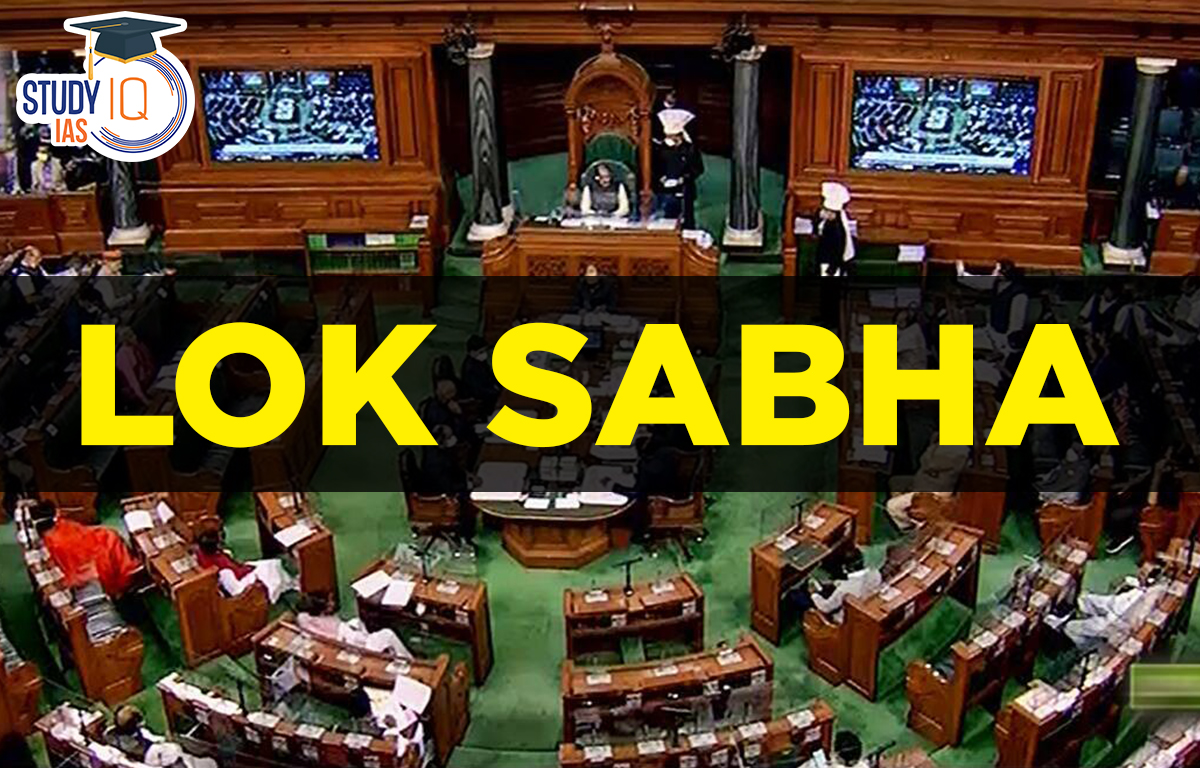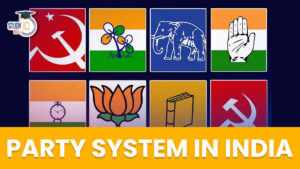Table of Contents
The Lok Sabha, also known as the House of the People, is the lower house of India’s bicameral parliament, with the upper house being the Rajya Sabha. It consists of 543 members, directly elected by the people of India on the basis of universal adult suffrage and a first-past-the-post system. The maximum membership of the House allotted by the Constitution of India is 552. After the first General Elections were held from 25 October 1951 to 21 February 1952, the Lok Sabha (House of the People) was legally formed for the first time on 17 April 1952.
Constitutional Provisions of Lok Sabha
The Lok Sabha’s composition is covered in Article 81. The maximum number, according to this article, should be as follows
| Provisions for Lok sabha |
|
List of Lok Sabha Members 2024
There are 543 member is the 18th Lok Sabha 2024. In this Bharatiya Janata Party (BJP) is the largest party with number of seats with 240, followed by the Indian National Congress (INC) is the second party with 99 seats. Other parties include the Samajwadi Party with 37 seats.
| List of 18th Lok Sabha Members – States/Union Territories | ||
| Name of State/ Union Territory |
Number of Lok Sabha Seats
|
|
|
Union Territories
|
Andaman & Nicobar Islands | 1 |
| Chandigarh | 1 | |
| Dadra & Nagar Haveli | 2 | |
| Daman & Diu | 1 | |
| Jammu & Kashmir | 5 | |
| Ladakh | 1 | |
| Lakshadweep | 1 | |
| NCT of Delhi | 7 | |
| Puducherry | 1 | |
Also, Check Differences between Lok Sabha and Rajya Sabha
Process of Selection of Lok Sabha Members
The process of selecting Lok Sabha members is a crucial part of India’s democratic system. It ensures that the people of India have the opportunity to choose their representatives and that the government is accountable to the people. The candidates must meet the following eligibility criteria:
| Eligibility criteria |
|
The process of selecting Lok Sabha members in India involves a series of steps, from the announcement of elections to the final declaration of results. Here is a detailed overview of the process:
- Delimitation of Constituencies
- Announcement of Election Dates
- Filing of Nominations
- Scrutiny of Nominations
- Withdrawal of Nominations
- Allotment of Symbols
- Campaigning
- Polling
- Counting of Votes
- Declaration of Results
- Notification of Elected Candidates
- Formation of the Government
Universal Adult Franchise (Article 326)
According to the 61st Amendment Act, every citizen who is at least 18 years old is eligible to vote in Lok Sabha elections. However, it is crucial that his name appear on the voters list for his constituency.
Reservation of Seats for SCs and STs
For Scheduled Castes and Scheduled Tribes, some constituencies are set aside. Reserved Constituencies are what they are known as. Only SC or ST candidates, if appropriate, may run for office from each reserved constituency. However, every voter in each of these constituencies exercises their right to vote to choose one SC or ST candidate to serve as their representative. 131 seats are currently reserved (84 for SCs and 47 for STs).
Single Member Territorial Constituencies
The number of geographical constituencies that make up the entire nation equals the number of Lok Sabha members that will be elected. Every constituency elects one MP.
Direct Election and Simple Majority Vote Victory System
All of the Lok Sabha’s members are chosen by popular vote. Any voter may cast a ballot to support the election of any candidate from his or her constituency. The candidate who receives the most votes among all candidates running in a constituency is chosen to serve as the Lok Sabha member representing the residents of that seat.
Read about: List of Vice Presidents of India
Speaker and Deputy Speaker of Lok Sabha
The Speaker of the Lok Sabha is elected from among the sitting members during the first meeting of the Lok Sabha and serves a five-year term. Typically, the Speaker belongs to the ruling party or coalition.
Election Process:
Members of Parliament (MPs) propose names for the Speaker, which are sent to the President. If only one name is proposed, no vote is needed. If there are multiple proposals, a vote is held.
Main Functions:
- Decides if a bill is a money bill.
- Maintains order and discipline in the house.
- Ranked 6th in order of precedence, alongside the Chief Justice of India.
The Speaker can be removed by a majority vote from the house, as per Articles 94 and 96 of the Indian Constitution. They can also be removed if a bill is incorrectly certified as a money bill.
The Deputy Speaker acts as the Speaker’s second-in-command and takes over when the Speaker is absent. The Deputy Speaker also serves a five-year term but can leave the post if they stop being an MP.
Lok Sabha Member Tenure
The ordinary tenure of the Lok Sabha is five years. Its duration may be increased in an emergency by one year. However, six months after the end of the emergency, new Lok Sabha elections must be held. Additionally, when the Prime Minister of India advises it or when no party is in a position to do so, the President has the power to dissolve the Lok Sabha. In this circumstance, a new Lok Sabha must also be legitimately elected within six months.
| Term of the Lok sabha |
|
Read about: List of Chief Ministers of India
Lok Sabha Sessions
Lok Sabha sessions are an essential part of India’s democratic process. They provide a platform for elected representatives to voice the concerns of the people, hold the government accountable, and shape the nation’s policies and laws. The President may call a session of Parliament at any time, although no more than six months must pass between meetings. It implies that the Lok Sabha must hold at least two sessions in a calendar year.
| The Lok Sabha, the lower house of India’s bicameral parliament, holds three sessions in a year: |
|
Lok Sabha Meeting
The Lok Sabha must have at least one-tenth of its total members present in order to constitute a quorum. The Speaker of the House has the authority to adjourn a Lok Sabha meeting for lack of quorum if 1/10th of the members are not present.
| There are two main types of Lok Sabha meetings: |
|
Read about: Viceroy of India
Lok Sabha Power and Functions
Legislative Powers
- Once a regular bill has been approved by both Houses of Parliament, it can then become law.
- Although common legislation may be introduced in either of the two chambers of Parliament, the Lok Sabha receives over 90% of the introductions.
- If a law passed by the Lok Sabha is rejected by the Rajya Sabha and returned with or without changes, the Lok Sabha reconsiders the bill.
- A deadlock results if the Lok Sabha approves it again but the Rajya Sabha is still unwilling to approve it.
- If this impasse is not broken after six months, the President calls a combined meeting of the two Houses in accordance with Article 108’s rules.
- Both Houses have agreed to the combined sitting’s decision.
Executive Powers
- The Council of Ministers is jointly liable before the Lok Sabha under Article 75(3).
- The Prime Minister is chosen by the majority in the Lok Sabha.
- The Lok Sabha is home to the majority of the ministries.
- As long as the majority in the Lok Sabha has confidence in them, the ministers remain in their positions.
- In accordance with the mechanism outlined in Rule 198 of the norms of procedure and conduct of business of the Lok Sabha, the Lok Sabha has the power to remove the ministry from office by voting a vote of no-confidence against it.
- As a result, the Lok Sabha has the power to make or break the Ministry.
- The Lok Sabha continues to have oversight of the Council of Ministers.
- Ministers can be questioned by MPs about the administration’s policies and activities.
- They are free to critique their actions.
- The Indian Constitution’s Article 75 confers the right to ask inquiries.
- They are capable of moving and adopting a variety of resolutions and motions (adjournment motion, call attention motion, censure motion, and no-confidence motion)
Financial Powers
- The Lok Sabha has extensive budgetary authority.
- A money bill may only be introduced in the Lok Sabha in accordance with the guidelines provided by Article 109.
- The money bill then moves on to the Rajya Sabha after being approved by it.
- The Lok Sabha Speaker decides if a certain law qualifies as a money bill or not in the event of a disagreement.
- His judgement is final, and there is no way to appeal it in a court, the Rajya Sabha, or the Lok Sabha.
- As a result, we can assert that the Lok Sabha has ultimate authority over the state’s finances.
- No tax can be imposed, collected, modified, or eliminated without the Lok Sabha’s consent.
- Without the Lok Sabha’s approval, the government cannot carry out its fiscal policy.
Judicial Powers
- A few judicial tasks are also carried out by the Lok Sabha.
- Both the Lok Sabha and the Rajya Sabha have the authority to consider the impeachment procedures against the President stated in Article 61.
- Only when both Houses have passed an impeachment resolution with a 2/3 majority of their members can the President be removed from office.
- Additionally, the Rajya Sabha’s allegations against India’s vice president are subject to scrutiny by the Lok Sabha.
- As per the guidelines set forth in Article 124 (4), the Lok Sabha and the Rajya Sabha may jointly adopt a resolution to dismiss any judge of the Supreme Court or of a State High Court.
- For the expulsion of some high-ranking state officials, such as the Attorney General of India, the Chief Election Commissioner, and the Comptroller and Auditor General of India, both Houses may pass a special address jointly and submit it to the President.
- In addition, the Lok Sabha has the authority to punish any individual who is found guilty of contempt of the House, whether they are a member or a citizen.
Electoral Functions
- Additionally, the Lok Sabha has some electoral duties.
- The Lok Sabha’s elected members participate in the presidential election.
- In accordance with Article 66 of the Indian Constitution, members of both the Lok Sabha and the Rajya Sabha vote to choose the vice president of India.
- The Lok Sabha’s members also choose from among themselves the Speaker and Deputy Speaker.
Read about: Preamble of Indian Constitution
Lok Sabha Members Grounds Of Disqualifications
Article 102 of the Indian Constitution outlines when a legislator can be disqualified from Parliament:
- Holding an office of profit under the government.
- Being declared of unsound mind by a court.
- Being an undischarged insolvent.
- Losing Indian citizenship.
- Being disqualified by a law passed by Parliament.
What is Office of Profit?
An office of profit is any government position that provides salaries or benefits. The amount gained does not matter.
Disqualifications under the Representation of Peoples Act (1951):
- Conviction for corrupt practices during elections.
- Conviction under certain laws like the Indian Penal Code or Prevention of Terrorism Act.
- Conviction resulting in at least two years of imprisonment.
- Dismissal from government for disloyalty or corruption.
- Failing to report election expenses.
Anti-Defection Law:
Established after a wave of defections in the 1967 elections, this law (1985) disqualifies members who:
- Don’t follow party leadership or resign.
- Don’t vote according to party instructions.
- Independent members who join a party.
- Nominated members who don’t join a party within six months.
The Chairman of Rajya Sabha and the Speaker of Lok Sabha have the authority to disqualify members on these grounds.
Vacation of Seats (Article 101): Members must vacate their seats if:
- Elected to both houses of Parliament.
- Become a member of both central and state legislatures.
- Become disqualified as per the rules.
- Are absent for 60 consecutive days without permission.
When a seat is vacated, elections are held to fill it.
Dissolution of the Lok Sabha
The President of India has the power to dissolve the Lok Sabha under Article 85 of the Indian Constitution. Dissolution can occur in two situations:
- When the five-year term of the Lok Sabha ends, and the ruling party leader dissolves it.
- When the government loses its majority and a floor test is imminent, allowing the President to dissolve the house.
- Dissolution is different from adjournment or prorogation; it marks the end of that Lok Sabha’s term.
Effects of Dissolution:
According to Articles 107 and 108, when the Lok Sabha is dissolved whether at the end of its term or earlier all pending business (bills, notices, motions, etc.) lapses. A new Lok Sabha must reintroduce all motions, bills, and notices once it is formed.


 Maharashtra Bill to Curb Urban Naxalism,...
Maharashtra Bill to Curb Urban Naxalism,...
 Party System in India, Feature, Importan...
Party System in India, Feature, Importan...
 Consolidated Fund of India, Meaning and ...
Consolidated Fund of India, Meaning and ...





















